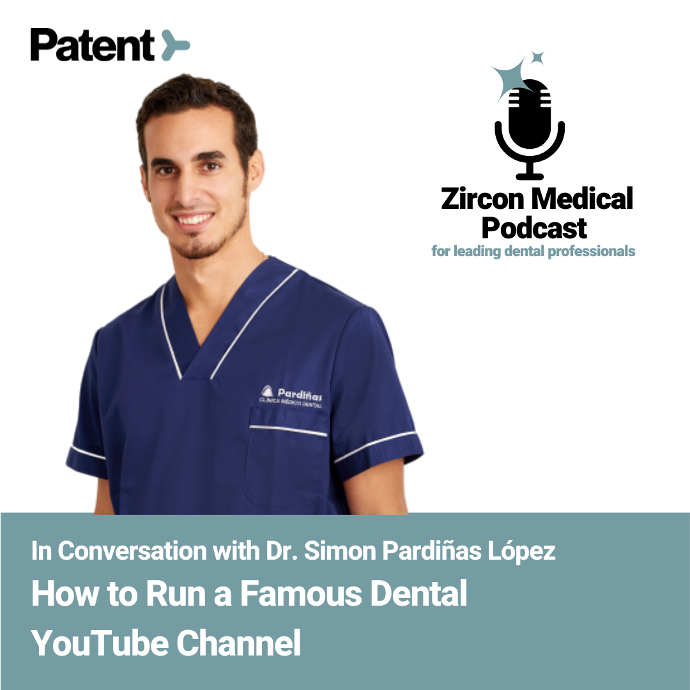Dr. Simon Pardiñas López
Dentist at Clinica Pardiñas in A Coruña
Extensive training in periodontics, implantology, and oral surgery
Creator of the most watched dental channel on YouTube in 2020 — Dentalk (860k subscribers)
CEO & Founder of DentalPlay and Dentoolapp, educational apps from dentists to dentists
New president of the Young Clinicians Committee of the American Academy of Osseointegration (AO) until 2025
- Website: https://www.clinicapardinas.com/
- LinkedIn: https://www.linkedin.com/in/dr-pardinaslopez
- Instagram: https://www.instagram.com/dr.pardinaslopez/
- TikTok: https://www.tiktok.com/@dr.pardinaslopez
YouTube: https://www.youtube.com/c/Dentalk
DentalPlay: https://www.dentalplay.es/
- Dentoolapp: https://dentoolapp.com/en
Rual, Rúa Real, 66, 3º, 15003 A Coruña, Spain
In Conversation with Dr. Simon Pardiñas López
Social media platforms like YouTube, TikTok, and Instagram are primarily made for socializing and entertainment. While it’s certainly possible to gain popularity and traction on social media with educational content, there’s a strong need to marry education with entertainment. Dr. Simon Pardiñas López strikes the perfect balance between education, humor, and entertainment, and the results speak for themselves — his YouTube channel Dentalk has amassed over 860,000 subscribers, making it the most popular dental YouTube channel in the world!
Our team at Zircon Medical recently hosted Dr. Pardiñas Lópezon our podcast series to discuss how to start and run a famous dental YouTube channel.
Introducing Dr. Pardiñas López, the owner of the most watched dental channel on YouTube
Dr. Pardiñas López is the leading dentist at his private practice named Clinica Pardiñas in A Coruña. He specializes in periodontics, implantology, and oral surgery and is a serial entrepreneur, having founded two educational apps for dentists — DentalPlay and Dentoolapp. He is the new president of the Young Clinicians Committee of the American Academy of Osseointegration (AO). And if that weren’t enough, he is also the creator of the world’s most-watched dental channel on YouTube — Dentalk. As of writing this article, Dentalk has over 860,000 subscribers, and the numbers grow every day.
Dr. Pardiñas López says he grew up listening to his parents talk about medicine and dentistry — he has physicians and dentists for his parents. That upbringing compelled him to pursue dentistry. Since his parents opened their dental clinic in 1986, they have been at the forefront of innovation. His father pioneered in implants in Spain, and they were one of the first clinics to create a website in the early 2000s. Starting a YouTube channel in the 2010s fell right in step with that spirit of innovation.
When they started the YouTube channel, they simply uploaded videos of their clinics and a few dental procedures. But that changed after Dr. Pardiñas López’s oral surgery residency program at NYU. When his mom visited, they discussed how they could explain treatments to patients better and came up with the idea of creating 3D images and videos. That’s when they started working with a 3D designer team to build the first 3D videos uploaded to YouTube.
They had initially intended to simply use the videos in the clinic. But the idea was so successful that they started uploading them to YouTube and amassed viewers. They now have 3D content on real-life procedures, orthodontics, surgeries, dental tips, and other dental subjects.
The content ideation and strategy process
To produce regular videos and content for various social media platforms, such as TikTok, YouTube, Facebook, Instagram, and LinkedIn, while running a dental clinic, seeing patients, and running two dental apps, there’s a strong need for a comprehensive content strategy.
When asked how he comes up with ideas for content, Dr. Pardiñas López says he finds inspiration from his patients. He receives a lot of questions as a dentist. While the questions he receives are fairly simple, he often can’t think of them because they come from a patient’s perspective. Those questions and their solutions end up being the subjects of his videos.
Additionally, Dr. Pardiñas López also mines current news and hot subjects for content. For example, if a football player breaks a tooth, he may take advantage of that situation to explain what can be done to resolve the problem. He says his mind is constantly looking for new subjects.
Dr. Pardiñas López says he tries to think like a patient and come up with common doubts and topics. After coming up with topics, he tries to explain the subject in simple language without scientific terms. For the 3D videos, the designer team works with him to produce the scripts. And for the rest of the videos, he scrips and records the videos individually, and then another individual optimizes them for social media.
The content production and upload cycle
Dr. Pardiñas López says he currently uploads one short video on all social media platforms daily, including Facebook, Instagram, LinkedIn, and TikTok. He spends approximately 30 to 40 minutes recording short videos of less than a minute. After recording the video, it’s modified according to the standards of each social media platform and uploaded. In our current social landscape, Dr. Pardiñas López says short videos of less than 60 seconds work the best, so they have to instantly send the message and capture the viewer’s interest.
However, Dr. Pardiñas López also allocates additional time for long-form videos that go into greater detail on specific subjects. Their long-form videos usually range from 10 to 15 minutes and are uploaded to YouTube, which is more conducive to longer content. If they produce long-form content on halitosis, they may explain the possible causes, treatments, home remedies, and more. Long-form videos go into greater detail on topics than smaller videos allow.
Dr. Pardiñas López says one of their most popular videos is about the relation between oral sex and oral health, having garnered millions of interactions. This particular video gained immense popularity because it explored a serious health-related subject that most people shied away from. “But this is a part of medicine and dentistry, and people need to know what happens if you don’t use protection,” Dr. Pardiñas López said. “It’s an important part of our profession to inform about risks and oral health considerations.”
The concept behind DentalPlay and Dentoolapp
Dr. Pardiñas López is the CEO and founder of two educational apps made for and by dentists — DentalPlay and Dentoolapp. Both apps are related to dental video and content production, and the idea for these apps came from the success found on the Dentalk YouTube channel.
“When we started uploading these videos to our YouTube channel, they became very popular,” Dr. Pardiñas López says. “Dentists and professionals started contacting us to find out where and how they could buy those videos. So we started these platforms where dentists and professionals can customize our videos with their clinic logos, select subtitles, and play in their waiting rooms and upload to websites. It was a gap in the market — not many companies had these kinds of 3D videos. Ours is the only group of videos in 4K quality.”
The DentalPlay app allows dentists to download 3D videos and images that they can play in their waiting rooms and upload to websites. The videos serve as excellent explainers for patients looking for information. The 3D animation videos in the DentalPlay app are often silent and come with subtitles in 15 different languages. That’s because they’re intended to be played in waiting rooms, and patients don’t usually like people talking in the background. The availability of multiple subtitles makes those videos suitable for people around the world.
The Dentoolapp app goes one step beyond DentalPlay. Available for iPads and Mac, the Dentoolapp platform gives dental professionals access to 3D videos that they can use to explain procedures to patients in real-time. They can draw over the videos, take screenshots, and interact with the videos to explain complex information in an easily digestible manner. The Dentoolapp app allows dentists to create profiles for their patients within the app to track their information and streamline communications.
The need for direct supervision of content
Dr. Pardiñas López says he works with a big team of 3D designers, but the rest of the team is fairly small. The entire team includes an individual for social media, the 3D designers, and another individual that helps the company expand globally. Dr. Pardiñas López is intimately involved with the company and controls and supervises every aspect of the content production to keep the scientific information strong and accurate.
“I often see in 3D images and videos in other sources that aren’t correct because they’re not supervised by dentists; only created by designers. This is a strong point for me. I need to supervise everything.” Dr. Pardiñas López’s desire to ensure the highest levels of scientific accuracy instead of focusing on expanding allows him to maintain integrity and produce high-level content.











